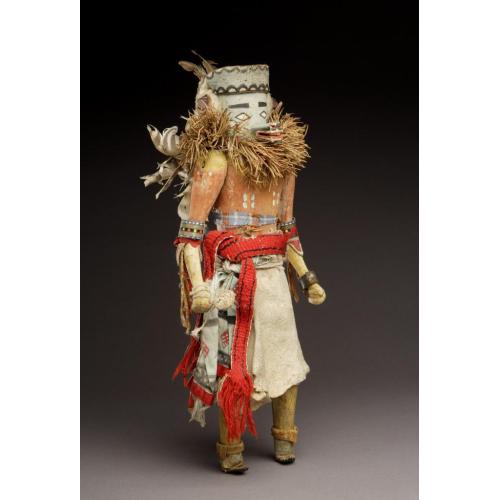
Photograph by Addison Doty. Copyright 2009 School for Advanced Research.
Wodem Thla kokko we'he | Mixed Group kokko figure
Artist or Maker: Unknown
Dimensions:
Overall: 40.6 cm (16 in.)
Medium: wood | paint | feathers | leather | cotton | wool | paper | pine needles
Place Made:
Zuni Pueblo, McKinley County, New Mexico, Southwest, United States, North America
Object Number: IAF.C5
Not on view
Tribal Collection Review RemarksJim Enote and Octavius Seowtewa during collection review visit April 6 and 7, 2009 (Events Record “Collection Review: Zuni Tribe, Review 1”): This kokko is part of the Mixed Group Dancers. There are several versions of the Wodem Thla dancers, including this one. Another version of this kokko is IAF.C92.
ADDITIONAL INFORMATION: Jim Enote and Octavius Seowtewa during collection review visit April 10 and 11, 2014 (Events Record “Collection Review: Zuni Tribe, Review 13”): This kokko figure is carved from wood, probably pine. The face and head are painted light blue. The paints used on the piece appear to be commercial, possibly poster paints. It has painted black eyes and five white diamonds with black outlines on each side of its face. The mouth is shaped like a tube with a carved mouth opening. It is painted light blue, black, white, and red. It has red nostrils. There is a strip of leather, similar to the shape of a crown, pinned to the top of the face with very small finishing nails. It’s painted mostly blue, with white water or cloud designs, outlined in black. The top of the head, and extending down to the neck, is covered in white cotton batting. It has horns made of leather that painted either orange or red. On the back of the head, there is a small stick inserted into the back of the evergreen ruff, from which a fan of turkey wing feathers hang from a white cotton string. There are two other feathers tied to it, pointing upward (it’s not know what kind of feathers these are). A turkey feather fan also points downward. This is the correct placement and orientation all of these feathers.
Around the figure’s neck is an evergreen ruff, with most of the needles still present and intact, though very dry and brittle.
Most of the figure’s torso and the middle of its upper arms are painted reddish orange. The upper portion of the torso, mostly hidden behind the evergreen ruff, is yellow. There are sixteen turquoise blue dots on the front of the torso and twenty-four of them on the back.
The arms are articulated at the shoulders and attached to the body with a nail through each shoulder. The shoulders are painted yellow, as are the forearms and hands. On each arm, there are four turquoise blue dots just below the yellow on the shoulders. The figure has a painted paper arm band on each arm, located just above the elbows. They are painted with red, black, yellow, green, blue, and white designs. Both arms also have a band of red rick-rac ribbon tied on the elbow, and below that a red and blue leather arm band with a fringe of brown leather attached to it. On the left arm, there is a black leather bow guard, held together with a piece of white cotton string. It is decorated with multi-faceted metal beads. The right arm holds a white rattle in its hand, tied on with white cotton string.
The figure wears a white, brain-tanned buckskin leather kilt. Over top of the kilt is tied a white cotton muslin sash painted to resemble an embroidered brocade sash. A strip of red ribbon is sewn the bottom edges of the sash. A woven red, black, and white sash belt is tied over top of the brocade sash and kilt. There are some sprigs of evergreens tucked into the top of the kilt, which are visible on the back of the piece. A strip of blue, white, and orange fabric is tied around the figure’s waist, above the kilt, for hanging it on a wall.
The legs are painted yellow and the figure wears handmade blue, red, and yellow leather moccasins with black soles.
There are several pieces missing from the kokko’s outfit as compared to what the dancer would wear. It’s missing the turquoise necklace, worn on the front, that the dancer would wear. Its left hand should hold a staff. It should have a turtle rattle on the back of its right leg, just below the knee, and there should be a black yarn tied onto the left leg, also just below the knee. The figure is missing the fox pelt that the dancer would wear over the back of its kilt.
In Collection(s)
Bibliography:
The Indian Arts Research Center, in collaboration with Native American community scholars, strives to present accurate collections records. Records may be updated as new information becomes available and is reviewed with the Native American community having cultural affinity to particular items. Please write to iarc@sarsf.org if you have questions or concerns related to the documentation.
